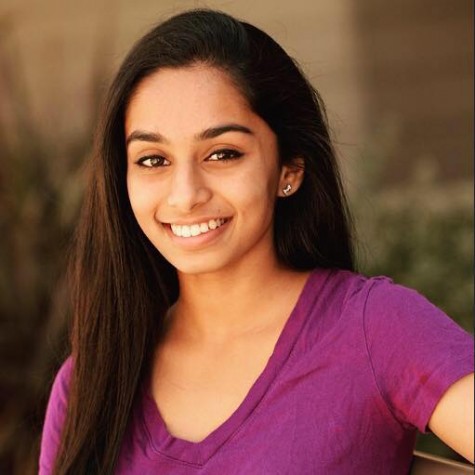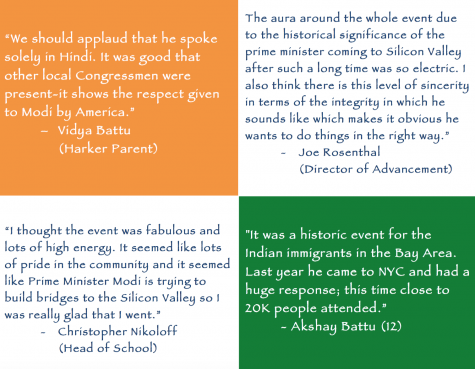Finding my cultural identity
I was sitting at my dining table shifting pens from side to side out of pure boredom when my dance teacher unexpectedly knocked on my door on a Tuesday afternoon.
My mom opened the door and it was clear that my dance teacher was very excited to share something. In English, she told us that she had just been invited to bring three of her students to dance with her at the Prime Minister of India’s reception at the SAP Center on Sept. 27. She had picked me as one of them.
Prime Minister of India, Sri Narendra Modi, visited the United States primarily to bridge more connections and supporters for his new initiative, Digital India, a campaign that aims to provide internet connectivity for the country’s poor, increase electronics manufacturing and improve government services through the use of technology. Modi also wanted inform the people of the United States that India is in fact a major player in the technology market.
His two day visit to the Silicon Valley included meeting with the named giants in technology including Facebook, Microsoft, Google, Apple, Adobe, and Tesla, each of whom embraced his Digital India initiative and showed eagerness to offer some of their platforms to the 1.29 billion civilians in India. In fact, three of these companies are run by Indian-Americans – direct evidence to Modi’s claim of India’s influence on tech.
The last prime minister to visit California arrived in 1961, exactly 54 years ago. That means nearly two generations of people have passed by before something of this magnitude has happened for Indians living here in the Silicon Valley.
The opportunity felt like the best thing ever but at the same time, I felt like I couldn’t relate to it as much as everyone around me could. I kept thinking about what my reaction would have been if the reception were for Obama.
Growing up in the home of Uncle Sam as a young, braid-adorning South Indian girl named “Sharanya” is confusing.
All my life, my parents have worked effortlessly to tie me to my “roots” by engaging me in various Indian traditions and instilling Indian cultural beliefs in me. I was put into an Indian classical dance studio right from the age of four, and before I could even talk I was told that resting my feet on any object other than the floor, like a book or a table, was deemed “disrespectful.” To this day, I don’t place any belongings near an area of eating because it is considered “impure.”
And as much as I embrace being a part of that vibrant Indian culture, every beat of the mridangam (the Indian drum) I hear just gets me dreaming more and more about eating greasy pizza while listening to 21st century hip hop. But every bite of cheesy goodness just leaves me longing for that spicy and tangy punch in your average bowl of reddish green chaat.
So which one am I? The Bharatnatyam dancer who can eat hara bhara bhel and pani poori 24/7? Or the sassy, if I must say, editor-in-chief of an online publication who loves rocking out with friends to Drake anywhere and everywhere they go? Which one is it?
Right before I went on stage, the crowd kept chanting “Hail Mother India” in Hindi. It gave me goose bumps to hear the conviction, pride and unification in the room of 20,000 people. It spoke to me in a way that I have never felt before. Something just felt right, but there were no words to explain it.
Dancing in an arena filled with uncontrollable energy was a surreal experience that completely took me over and electrified me. Every move I made for that crowd on that stage made me feel on top of the world.
And trust me, as I got off stage and back into the audience, I truly felt like a different person.
After rejoining the audience, it was time. In the 10 seconds leading up to Prime Minister Modi’s entrance, the crowd was on its feet and shouting louder than ever. For the first time ever, I felt a rightful sense of belonging.
As both the United States and Indian national anthems were sung back to back in unison by whole audience with many Congressmen and Prime Minister Modi onstage, I knew that I was not Indian or American but rather Indian-American.
Throughout Modi’s speech he highlighted his goals and visions of improving India’s current infrastructure and eradicating corruption through e-governance. But he equally stressed his thankfulness to the Indian-American community in Silicon Valley for the name and fame they have brought to India because of their, in his own words, “magic on the keyboard.” This obvious balance of topics made by the Prime Minister himself made me feel much more at peace with my previous doubts and questions.
“You have played well on the computer and created a new identity for India,” Modi said in his address. “And when the citizens of my country and the young people of my country go abroad living in a foreign country take the entire world in a new direction, a person like me feels so happy and delighted. Therefore, by increasing the glory of India, by increasing the respect for India, by forcing the whole world to see us in a new way, the determination you have shown, I salute you and immensely thank you from the bottom of my heart.”
Hearing that Modi himself had seen a drastic change in the presence of Indians in California over the past 25 years confirmed to me that our cultural marriage was real and accepted.
If Modi himself can lean on biggest technological companies based in the Silicon Valley to help him in his own mission of increasing internet connectivity across India while those same companies can generously offer their hands to support foreign nations like India, there is an obvious solidarity between India and America that can not be dismissed.
The very fact that three of these companies are run by Indian-American individuals, who could not have had the same impact they have had on this world without both of their backgrounds, proves to show that they aren’t Indian. They aren’t American.
They are Indian-American, and so am I.
Many of those in the Harker community attended the event. Here is what some of them had to say.

Sharanya Balaji (12) is the Editor-In-Chief for Harker Aquila and has been on staff for the past three years. Additionally, during her freshman year she...


















![“[Building nerf blasters] became this outlet of creativity for me that hasn't been matched by anything else. The process [of] making a build complete to your desire is such a painstakingly difficult process, but I've had to learn from [the skills needed from] soldering to proper painting. There's so many different options for everything, if you think about it, it exists. The best part is [that] if it doesn't exist, you can build it yourself," Ishaan Parate said.](https://harkeraquila.com/wp-content/uploads/2022/08/DSC_8149-900x604.jpg)




![“When I came into high school, I was ready to be a follower. But DECA was a game changer for me. It helped me overcome my fear of public speaking, and it's played such a major role in who I've become today. To be able to successfully lead a chapter of 150 students, an officer team and be one of the upperclassmen I once really admired is something I'm [really] proud of,” Anvitha Tummala ('21) said.](https://harkeraquila.com/wp-content/uploads/2021/07/Screen-Shot-2021-07-25-at-9.50.05-AM-900x594.png)







![“I think getting up in the morning and having a sense of purpose [is exciting]. I think without a certain amount of drive, life is kind of obsolete and mundane, and I think having that every single day is what makes each day unique and kind of makes life exciting,” Neymika Jain (12) said.](https://harkeraquila.com/wp-content/uploads/2017/06/Screen-Shot-2017-06-03-at-4.54.16-PM.png)








![“My slogan is ‘slow feet, don’t eat, and I’m hungry.’ You need to run fast to get where you are–you aren't going to get those championships if you aren't fast,” Angel Cervantes (12) said. “I want to do well in school on my tests and in track and win championships for my team. I live by that, [and] I can do that anywhere: in the classroom or on the field.”](https://harkeraquila.com/wp-content/uploads/2018/06/DSC5146-900x601.jpg)
![“[Volleyball has] taught me how to fall correctly, and another thing it taught is that you don’t have to be the best at something to be good at it. If you just hit the ball in a smart way, then it still scores points and you’re good at it. You could be a background player and still make a much bigger impact on the team than you would think,” Anya Gert (’20) said.](https://harkeraquila.com/wp-content/uploads/2020/06/AnnaGert_JinTuan_HoHPhotoEdited-600x900.jpeg)

![“I'm not nearly there yet, but [my confidence has] definitely been getting better since I was pretty shy and timid coming into Harker my freshman year. I know that there's a lot of people that are really confident in what they do, and I really admire them. Everyone's so driven and that has really pushed me to kind of try to find my own place in high school and be more confident,” Alyssa Huang (’20) said.](https://harkeraquila.com/wp-content/uploads/2020/06/AlyssaHuang_EmilyChen_HoHPhoto-900x749.jpeg)




